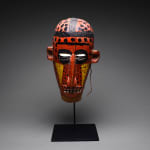Bambara Wooden Polychrome Face Mask, 20th Century CE
Wood and Paint
33.7 x 20.3 cm
13 1/4 x 8 in
13 1/4 x 8 in
PF.3502
Further images
Living southwest of the Dogon, the Bambara have a rich artistic heritage. Among their most celebrated creations are the headdresses and masks representing antelopes (called chi wara), symbols representing agricultural...
Living southwest of the Dogon, the Bambara have a rich artistic heritage. Among their most celebrated creations are the headdresses and masks representing antelopes (called chi wara), symbols representing agricultural prosperity. To the ancient inhabitants of Mali, bountiful harvests were essential considering their livelihood depended upon the abundance of crops. Thus, much of their art is dedicated to the life affirming activities of humans, and people performed dance rituals, with art works such as this colorful mask, to bring prosperity.
Painted with bright colors of red, yellow, white, and black, this mask instantly grabs our attention. As festive as the agricultural ceremony in which it has participated, the mask undoubtedly expresses a strong wish for a prosperous harvest. The mask is painted bright red while painted black dots decorate the surface. Moreover, large yellow triangular shapes filled with small black dots enhance the cheeks of the mask. Possibly representing facial scarification or face paint pattern, such marks may indicate status or identity of the person participating in the ritual. The large mouth is open to reveal intricately carved teeth that are painted white. Such dramatic feature possibly signifies mastication, consumption, and ultimately nourishment. Decorated with brilliant colors and great symbolic attributes, this ceremonial mask is absolutely dazzling.
Painted with bright colors of red, yellow, white, and black, this mask instantly grabs our attention. As festive as the agricultural ceremony in which it has participated, the mask undoubtedly expresses a strong wish for a prosperous harvest. The mask is painted bright red while painted black dots decorate the surface. Moreover, large yellow triangular shapes filled with small black dots enhance the cheeks of the mask. Possibly representing facial scarification or face paint pattern, such marks may indicate status or identity of the person participating in the ritual. The large mouth is open to reveal intricately carved teeth that are painted white. Such dramatic feature possibly signifies mastication, consumption, and ultimately nourishment. Decorated with brilliant colors and great symbolic attributes, this ceremonial mask is absolutely dazzling.







